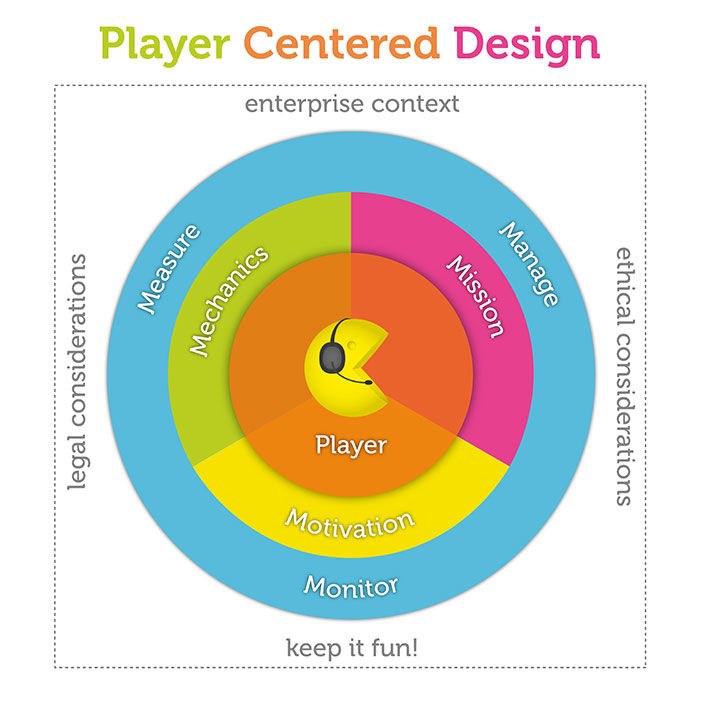"Games give us unnecessary obstacles that we volunteer to tackle."
— Jane McGonigal
When starting to implement gamification into your enterprise software, it may be difficult to know where to begin. It is tempting to jump straight to mechanics and start thinking about points, badges, and leaderboards. Instead, we suggest a different approach. We recommend a process inspired by a well-established design philosophy called User Centered Design.
2.1 What is User Centered Design?
User Centered Design is a philosophy that puts the user, and their goals, at the center of the design and development process. It strives to develop products that are tightly aligned with the user's needs.
In contrast, poorly designed products are a result of Data Centered Design, or Technology Centered Design, which considers technical artifacts such as the database tables, to create a series of forms that allows the user to "put and get" the data. Developers are naturally drawn to this approach because it is easy to achieve technically, and is the path of least resistance when the team is under time pressure. Moreover, engineers have a clear mental model of the data, and may assume that everyone shares this. However, it has been proven repeatedly that most users do not share this view of the application. They are busy getting their job done, interacting with others, and having fun.
While User Centered Design is certainly better than Data Centered Design, we believe that introducing gamification into software requires the designer to go one step further and use a process that we call Player Centered Design.
2.2 Beyond User Centered Design
Designers who adopt the user centered design philosophy in their daily work pay attention to the user's goals, and strive to build products that help the user achieve them in an efficient, effective, and satisfactory manner (footnote 1).
While effectiveness, efficiency, and satisfaction are worthy goals, gaming and gamification extends and adds increased engagement to these goals. In the context of a game, players voluntarily seek challenges to enhance their playing experience. They seek empowerment over efficiency, delight and fun over mere satisfaction. These factors increase their level of engagement in the game.
2.3 Overview of Player Centered Design Process
To help designers deal with these changing rules and rising expectations, we introduce a concept called Player Centered Design that puts the player at the center of the design and development process. The figure below illustrates the process of Player Centered Design and outlines the various steps to help structure your gamification project.
 Courtesy of Janaki Kumar and Mario Herger. Copyright: CC-Att-ND (Creative Commons Attribution-NoDerivs 3.0 Unported).
Courtesy of Janaki Kumar and Mario Herger. Copyright: CC-Att-ND (Creative Commons Attribution-NoDerivs 3.0 Unported).
Figure 2.1: Player Centered Design Process
The goal of this process is to provide a framework in which to think about gamification. It is not meant to be a series of rigid, uni-directional steps, but rather an iterative and adaptive framework. We encourage you to review this process in the context of your own organization and modify it if needed, while closely monitoring results.
2.3.1 Understand the player
The first step in the player centered design approach is to understand the player and his/her context. The success of your gamification efforts depends on this clear understanding.
Is your player a sales representative, a financial controller, an employee, a supplier, or a customer? Identify him/her and understand as much as you can about him/her.Chapter 3 will elaborate on the multiple facets of a player and his/her relationship to gaming preferences.
2.3.2 Understand the Mission
The next step is to define the Mission. This step involves understanding the current business scenario (what players are doing today), identifying the desired or target business outcome (what management wants to achieve), and setting an appropriate mission for your gamification project.
Chapter 4 outlines the techniques that will help analyze the current scenario and identify the target business outcome. The chapter offers guidelines to set a specific, measurable, actionable, realistic and time-bound (S.M.A.R.T.) gamification mission based on this analysis.
Player centered design is an iterative process. Therefore, while defining the mission, you will learn more about the player; it is worthwhile to consider this new information and its impact on gamification.
2.3.3 Understand Human Motivation
There are a number of theories of human motivation. We recommend you familiarize yourself with the latest research on motivation in order to create effective game mechanics. Chapter 5 will present a curated list of motivational drivers to get you started and introduce you to additional resources.
2.3.4 Apply Game Mechanics
Armed with a clear understanding of the player, the mission, and the theory behind human motivation, it is time to apply game mechanics, and create a positive flow for your gamification project. Game mechanics refer to the UI elements with which a player interacts such as badges, points, leaderboards and many more. Chapter 6 provides a list of game mechanics relevant to enterprise software.
2.3.5 Manage, Monitor and Measure
Gamification is a program and not a project. Therefore, it is important to start small, closely monitor progress, and adjust as needed. The mission needs to be managed, the motivation needs to be monitored, and mechanics need to be measured continuously.
Chapter 7 elaborates on how to manage gamification of enterprise software successfully, and increase player engagement. It offers tips for success in a corporate environment.
2.3.6 Other considerations in the enterprise context
Chapter 8 elaborates on the legal and ethical considerations that impact gamification in the context of the enterprise. Privacy and workers' protection practices vary between countries, and what may be legal in one country may not be in another.
The ethics of gamification need to be considered as part of any project. Gamification can be used to engage and motivate, but never manipulate.
The ultimate goal of gamification is to engender positive emotions in the player such as fun, trust and delight. It is important not to forget this when working on the serious aspects of gamification.
We provide a number of enterprise gamification examples in chapter 9, with a link to a website with many more.
2.4 Summary
In this chapter, we have presented a process of gamification, which we call Player Centered Design. It is inspired by User Centered Design, but goes beyond UCD to incorporate the concept of engagement. The process begins with a good understanding of both the player and the mission. This is followed by psychological research on motivation. Based on this solid foundation, we advocate a thoughtful application of game mechanics. We recommend you start small, monitoring closely for best results. The enterprise context including legal and ethical considerations cannot be ignored. And remember to make it fun!
2.5 Insights from SAP Community Network
The SCN launch team conducted dozens of interviews with developers inside and outside SAP to understand their work practices, the way they learnt about new technologies, and how they communicated with their personal network.
The interviews revealed a number of interesting facts that later became crucial to the success of this professional community. For example, developers tend to be very open in their communication and are willing to share their expertise. They are less concerned about legal issues, or trade secrets. They prefer to tell the community candidly what is working in the software and what is not. Developers stated that it was important for them to assist their network. They believed that it was more beneficial to do so for their employers than to keep their knowledge to themselves. This information helped us to understand the SCN players, their mission and their motivations.
To be continued at the end of next chapter...

